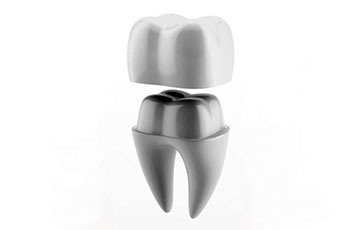Crowns
A dental crown, sometimes called a cap, completely covers your damaged tooth. It is cemented into place and offers a strong, solid, good-looking replacement for a natural tooth. A crown is created in a lab and is made from models your dentist makes with impressions, so it fits your mouth perfectly; replicating the shape, size and position of your severely damaged tooth.

Reasons your dentist would recommend a dental crown:
- To replace a large filling that no longer has enough tooth structure to continue to fill the cavity
- To protect a weak tooth from further chipping, breaking or fracturing
- To restore a fractured/cracked tooth
- To cover a poorly shaped tooth or discolored tooth
- To attach a dental bridge (see more below)
- To protect and restore a tooth that has had a root canal
- To cover a dental implant
No matter the reason you need a crown, it is well worth it. Your tooth will be stronger and more stable, it will last longer, it will look better, and you’ll feel better.
Bridges
Missing a tooth and having a gap in between your teeth isn’t just unsightly, it can cause other problems. Talking and chewing may be difficult. Teeth adjacent to the space will eventually begin to shift into the empty space which will affect your bite, may lead to gum disease and possibly even jaw joint disorders like temporomandibular joint (TMJ) issues.
One way to take care of a gap caused by a missing tooth is with a dental bridge. There are removable dental bridges, also called partial dentures, that can be removed and cleaned like dentures, and there are permanent dental bridges, sometimes called fixed partial dentures.
A dental bridge is called a bridge because it literally bridges the gap where one or more teeth used to be. Bridges are cemented to the teeth adjacent to the empty space. The adjacent teeth, called abutments, serve as the anchors for the bridge. The adjacent teeth are trimmed down and capped with a crown, and then a replacement tooth, called a pontic, is attached to those crowns to form the bridge. The unit is securely cemented to your teeth and your smile and ability to chew food is improved.
Dental bridges help you:
- Restore the ability to chew and speak properly
- Maintain the shape of your face, preventing lip or face collapse
- Distribute the forces in your bite to alleviate stress on other teeth
- Prevent remaining teeth from shifting out of position and into the gap
There are several types of dental bridges. Each bridge is made with different materials and is better suited for certain areas of the mouth and for certain types of situations.
LIProsthodontics is here to provide you and your family the highest quality dental care; creating healthy and beautiful smiles in a relaxing environment. We are dedicated to providing you with the highest standards of care in Restorative, Cosmetic, Implant, and General Dentistry.